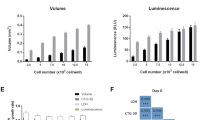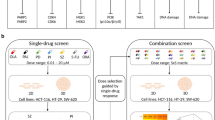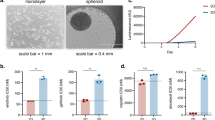Abstract
Although used in academic research for several decades, 3D culture models have long been regarded expensive, cumbersome and unnecessary in drug development processes. Technical advances, coupled with recent observations showing that gene expression in 3D is much closer to clinical expression profiles than those seen in 2D, have renewed attention and generated hope in the feasibility of maturing organotypic 3D systems to therapy test platforms with greater power to predict clinical efficacies. Here we describe a standardized setup for reproducible, easy-handling culture, treatment and routine analysis of multicellular spheroids, the classical 3D culture system resembling many aspects of the pathophysiological situation in human tumor tissue. We discuss essential conceptual and practical considerations for an adequate establishment and use of spheroid-based drug screening platforms and also provide a list of human carcinoma cell lines, partly on the basis of the NCI-DTP 60-cell line screen, that produce treatable spheroids under identical culture conditions. In contrast to many other settings with which to achieve similar results, the protocol is particularly useful to be integrated into standardized large-scale drug test routines as it requires a minimum number of defined spheroids and a limited amount of drug. The estimated time to run the complete screening protocol described herein—including spheroid initiation, drug treatment and determination of the analytical end points (spheroid integrity, and cell survival through the acid phosphatase assay)—is about 170 h. Monitoring of spheroid growth kinetics to determine growth delay and regrowth, respectively, after drug treatment requires long-term culturing (≥14 d).
This is a preview of subscription content, access via your institution
Access options
Subscribe to this journal
Receive 12 print issues and online access
$259.00 per year
only $21.58 per issue
Buy this article
- Purchase on Springer Link
- Instant access to full article PDF
Prices may be subject to local taxes which are calculated during checkout






Similar content being viewed by others
References
Abbott, A. Cell culture: biology's new dimension. Nature 424, 870–872 (2003).
Kunz-Schughart, L.A., Freyer, J.P., Hofstaedter, F. & Ebner, R. The use of 3-D cultures for high-throughput screening: the multicellular spheroid model. J. Biomol. Screen 9, 273–285 (2004).
Friedrich, J. et al. A reliable tool to determine cell viability in complex 3-d culture: the Acid phosphatase assay. J. Biomol. Screen. 12, 925–937 (2007).
Gudjonsson, T., Ronnov-Jessen, L., Villadsen, R., Bissell, M.J. & Petersen, O.W. To create the correct microenvironment: three-dimensional heterotypic collagen assays for human breast epithelial morphogenesis and neoplasia. Methods 30, 247–255 (2003).
Nelson, C.M. & Bissell, M.J. Modeling dynamic reciprocity: engineering three-dimensional culture models of breast architecture, function, and neoplastic transformation. Semin. Cancer Biol. 15, 342–352 (2005).
Lee, G.Y., Kenny, P.A., Lee, E.H. & Bissell, M.J. Three-dimensional culture models of normal and malignant breast epithelial cells. Nat. Methods 4, 359–365 (2007).
Friedrich, J., Ebner, R. & Kunz-Schughart, L.A. Experimental anti-tumor therapy in 3-D: spheroids—old hat or new challenge? Int. J. Radiat. Biol. 83, 849–871 (2007).
Mueller-Klieser, W. Multicellular spheroids. A review on cellular aggregates in cancer research. J. Cancer Res. Clin. Oncol. 113, 101–122 (1987).
Kunz-Schughart, L.A., Kreutz, M. & Knuechel, R. Multicellular spheroids: a three-dimensional in vitro culture system to study tumour biology. Int. J. Exp. Pathol. 79, 1–23 (1998).
Santini, M.T. & Rainaldi, G. Three-dimensional spheroid model in tumor biology. Pathobiology 67, 148–157 (1999).
Khaitan, D., Chandna, S., Arya, M.B. & Dwarakanath, B.S. Establishment and characterization of multicellular spheroids from a human glioma cell line: implications for tumor therapy. J. Transl. Med. 4, 12 (2006).
Dubessy, C., Merlin, J.M., Marchal, C. & Guillemin, F. Spheroids in radiobiology and photodynamic therapy. Crit. Rev. Oncol. Hematol. 36, 179–192 (2000).
Ballangrud, A.M. et al. Response of LNCaP spheroids after treatment with an alpha-particle emitter (213Bi)-labeled anti-prostate-specific membrane antigen antibody (J591). Cancer Res. 61, 2008–2014 (2001).
Durand, R.E. & Olive, P.L. Resistance of tumor cells to chemo- and radiotherapy modulated by the three-dimensional architecture of solid tumors and spheroids. Methods Cell Biol. 64, 211–233 (2001).
Mueller-Klieser, W. Three-dimensional cell cultures: from molecular mechanisms to clinical applications. Am. J. Physiol. 273, C1109–C1123 (1997).
Al-Hajj, M., Becker, M.W., Wicha, M., Weissman, I. & Clarke, M.F. Therapeutic implications of cancer stem cells. Curr. Opin. Genet. Dev. 14, 43–7 (2004).
Vermeulen, L. et al. Single-cell cloning of colon cancer stem cells reveals a multi-lineage differentiation capacity. Proc. Natl. Acad. Sci. USA 105, 13427–13432 (2008).
Barbone, D., Yang, T.M., Morgan, J.R., Gaudino, G. & Broaddus, V.C. Mammalian target of rapamycin contributes to the acquired apoptotic resistance of human mesothelioma multicellular spheroids. J. Biol. Chem. 283, 13021–13030 (2008).
Desoize, B. & Jardillier, J. Multicellular resistance: a paradigm for clinical resistance? Crit. Rev. Oncol. Hematol. 36, 193–207 (2000).
Mueller-Klieser, W. Tumor biology and experimental therapeutics. Crit. Rev. Oncol. Hematol. 36, 123–139 (2000).
Carlsson, J. & Acker, H. Relations between pH, oxygen partial pressure and growth in cultured cell spheroids. Int. J. Cancer 42, 715–720 (1988).
Poland, J. et al. Comparison of protein expression profiles between monolayer and spheroid cell culture of HT-29 cells revealed fragmentation of CK18 in three-dimensional cell culture. Electrophoresis 23, 1174–1184 (2002).
Frankel, A., Man, S., Elliott, P., Adams, J. & Kerbel, R.S. Lack of multicellular drug resistance observed in human ovarian and prostate carcinoma treated with the proteasome inhibitor PS-341. Clin. Cancer Res. 6, 3719–3728 (2000).
Eshleman, J.S. et al. Inhibition of the mammalian target of rapamycin sensitizes U87 xenografts to fractionated radiation therapy. Cancer Res. 62, 7291–7297 (2002).
Oloumi, A., Lam, W., Banath, J.P. & Olive, P.L. Identification of genes differentially expressed in V79 cells grown as multicell spheroids. Int. J. Radiat. Biol. 78, 483–492 (2002).
Jelic, S. Molecular basis of future patients-tailored treatment. Arch. Oncol. 13, 56–58 (2005).
Liu, M. et al. Antitumor activity of rapamycin in a transgenic mouse model of ErbB2-dependent human breast cancer. Cancer Res. 65, 5325–5336 (2005).
Dardousis, K. et al. Identification of differentially expressed genes involved in the formation of multicellular tumor spheroids by HT-29 colon carcinoma cells. Mol. Ther. 15, 94–102 (2007).
Howes, A.L. et al. The phosphatidylinositol 3-kinase inhibitor, PX-866, is a potent inhibitor of cancer cell motility and growth in three-dimensional cultures. Mol. Cancer Ther. 6, 2505–2514 (2007).
Kunz-Schughart, L.A. Multicellular tumor spheroids: intermediates between monolayer culture and in vivo tumor. Cell Biol. Int. 23, 157–161 (1999).
Furbert-Harris, P.M. et al. Eosinophils in a tri-cell multicellular tumor spheroid (MTS)/endothelium complex. Cell Mol. Biol. 49, 1081–1088 (2003).
Gottfried, E., Kunz-Schughart, L.A., Andreesen, R. & Kreutz, M. Brave little world: spheroids as an in vitro model to study tumor-immune-cell interactions. Cell Cycle 5, 691–695 (2006).
Spoettl, T. et al. Monocyte chemoattractant protein-1 (MCP-1) inhibits the intestinal-like differentiation of monocytes. Clin. Exp. Immunol. 145, 190–199 (2006).
Wartenberg, M., Finkensieper, A., Hescheler, J. & Sauer, H. Confrontation cultures of embryonic stem cells with multicellular tumor spheroids to study tumor-induced angiogenesis. Methods Mol. Biol. 331, 313–328 (2006).
Gunther, S. et al. Polyphenols prevent cell shedding from mouse mammary cancer spheroids and inhibit cancer cell invasion in confrontation cultures derived from embryonic stem cells. Cancer Lett. 250, 25–35 (2007).
Li, Z.W. & Dalton, W.S. Tumor microenvironment and drug resistance in hematologic malignancies. Blood Rev. 20, 333–342 (2006).
Kunz-Schughart, L.A. & Mueller-Klieser, W. Three-dimensional culture. In Animal Cell Culture Vol. 3 (Ed. Masters, J.R.W.) 123–148 (Oxford University Press, Oxford, 2000).
Stark, H.J., Baur, M., Breitkreutz, D., Mirancea, N. & Fusenig, N.E. Organotypic keratinocyte cocultures in defined medium with regular epidermal morphogenesis and differentiation. J. Invest. Dermatol. 112, 681–691 (1999).
Stark, H.J. et al. Epidermal homeostasis in long-term scaffold-enforced skin equivalents. J. Investig. Dermatol. Symp. Proc. 11, 93–105 (2006).
Korff, T. & Augustin, H.G. Integration of endothelial cells in multicellular spheroids prevents apoptosis and induces differentiation. J. Cell Biol. 143, 1341–1352 (1998).
Ivascu, A. & Kubbies, M. Rapid generation of single-tumor spheroids for high-throughput cell function and toxicity analysis. J. Biomol. Screen 11, 922–932 (2006).
Kosaka, T. et al. Comparison of various methods of assaying the cytotoxic effects of ethanol on human hepatoblastoma cells (HUH-6 line). Acta. Med. Okayama 50, 151–156 (1996).
Enmon, R. et al. Combination treatment with 17-N-allylamino-17-demethoxy geldanamycin and acute irradiation produces supra-additive growth suppression in human prostate carcinoma spheroids. Cancer Res. 63, 8393–8399 (2003).
Fehlauer, F. et al. Effects of irradiation and cisplatin on human glioma spheroids: inhibition of cell proliferation and cell migration. J. Cancer Res. Clin. Oncol. 131, 723–732 (2005).
Lambert, B. et al. Screening for supra-additive effects of cytotoxic drugs and gamma irradiation in an in vitro model for hepatocellular carcinoma. Can. J. Physiol. Pharmacol. 82, 146–152 (2004).
Sutherland, R.M. Cell and environment interactions in tumor microregions: the multicell spheroid model. Science 240, 177–184 (1988).
LaRue, K.E., Khalil, M. & Freyer, J.P. Microenvironmental regulation of proliferation in multicellular spheroids is mediated through differential expression of cyclin-dependent kinase inhibitors. Cancer Res. 64, 1621–1631 (2004).
Francia, G., Man, S., Teicher, B., Grasso, L. & Kerbel, R.S. Gene expression analysis of tumor spheroids reveals a role for suppressed DNA mismatch repair in multicellular resistance to alkylating agents. Mol. Cell. Biol. 24, 6837–6849 (2004).
Francia, G. et al. Down-regulation of DNA mismatch repair proteins in human and murine tumor spheroids: implications for multicellular resistance to alkylating agents. Mol. Cancer Ther. 4, 1484–1494 (2005).
Bindra, R.S., Crosby, M.E. & Glazer, P.M. Regulation of DNA repair in hypoxic cancer cells. Cancer Metastasis Rev 26, 249–260 (2007).
Romero, F.J., Zukowski, D. & Mueller-Klieser, W. Glutathione content of V79 cells in two- or three-dimensional culture. Am. J. Physiol. 272, C1507–C1512 (1997).
Winters, B.S., Raj, B.K., Robinson, E.E., Foty, R.A. & Corbett, S.A. Three-dimensional culture regulates Raf-1 expression to modulate fibronectin matrix assembly. Mol. Biol. Cell 17, 3386–3396 (2006).
Carlsson, J. & Yuhas, J.M. Liquid-overlay culture of cellular spheroids. Recent Results Cancer Res. 95, 1–23 (1984).
Tong, J.Z. et al. Long-term culture of adult rat hepatocyte spheroids. Exp. Cell Res. 200, 326–332 (1992).
Hoevel, T., Macek, R., Swisshelm, K. & Kubbies, M. Reexpression of the TJ protein CLDN1 induces apoptosis in breast tumor spheroids. Int. J. Cancer 108, 374–383 (2004).
Wartenberg, M. et al. Development of an intrinsic P-glycoprotein-mediated doxorubicin resistance in quiescent cell layers of large, multicellular prostate tumor spheroids. Int. J. Cancer 75, 855–863 (1998).
Kunz-Schughart, L.A. & Freyer, J.P. Adaptation of an automated selective dissociation procedure to two novel spheroid types. In Vitro Cell. Dev. Biol. Anim. 33, 73–76 (1997).
Kerr, D.J., Wheldon, T.E., Kerr, A.M. & Kaye, S.B. In vitro chemosensitivity testing using the multicellular tumor spheroid model. Cancer Drug Deliv. 4, 63–74 (1987).
Durand, R.E. Slow penetration of anthracyclines into spheroids and tumors: a therapeutic advantage? Cancer Chemother. Pharmacol. 26, 198–204 (1990).
Freyer, J.P. & Schor, P.L. Automated selective dissociation of cells from different regions of multicellular spheroids. In Vitro Cell Dev. Biol. 25, 9–19 (1989).
Watanabe, N., Hirayama, R. & Kubota, N. The chemopreventive flavonoid apigenin confers radiosensitizing effect in human tumor cells grown as monolayers and spheroids. J. Radiat. Res. (Tokyo) 48, 45–50 (2007).
Essand, M., Nilsson, S. & Carlsson, J. Growth of prostatic cancer cells, DU 145, as multicellular spheroids and effects of estramustine. Anticancer Res. 13, 1261–1268 (1993).
Russell, J., Wheldon, T.E. & Stanton, P. A radioresistant variant derived from a human neuroblastoma cell line is less prone to radiation-induced apoptosis. Cancer Res. 55, 4915–4921 (1995).
Marusic, M., Bajzer, Z., Vuk-Pavlovic, S. & Freyer, J.P. Tumor growth in vivo and as multicellular spheroids compared by mathematical models. Bull. Math. Biol. 56, 617–631 (1994).
Kunz-Schughart, L.A., Groebe, K. & Mueller-Klieser, W. Three-dimensional cell culture induces novel proliferative and metabolic alterations associated with oncogenic transformation. Int. J. Cancer 66, 578–586 (1996).
Tabatabai, M., Williams, D.K. & Bursac, Z. Hyperbolastic growth models: theory and application. Theor. Biol. Med. Model. 2, 14–15 (2005).
Mellor, H.R., Ferguson, D.J. & Callaghan, R. A model of quiescent tumour microregions for evaluating multicellular resistance to chemotherapeutic drugs. Br. J. Cancer 93, 302–309 (2005).
Orlandi, P. et al. Idarubicin and idarubicinol effects on breast cancer multicellular spheroids. J. Chemother. 17, 663–667 (2005).
Lambert, B. et al. Assessment of supra-additive effects of cytotoxic drugs and low dose rate irradiation in an in vitro model for hepatocellular carcinoma. Can. J. Physiol. Pharmacol. 84, 1021–1028 (2006).
Hirschberg, H., Sun, C.H., Krasieva, T. & Madsen, S.J. Effects of ALA-mediated photodynamic therapy on the invasiveness of human glioma cells. Lasers Surg. Med. 38, 939–945 (2006).
Minchinton, A.I. & Tannock, I.F. Drug penetration in solid tumours. Nat. Rev. Cancer 6, 583–592 (2006).
Xiao, Z., Hansen, C.B., Allen, T.M., Miller, G.G. & Moore, R.B. Distribution of photosensitizers in bladder cancer spheroids: implications for intravesical instillation of photosensitizers for photodynamic therapy of bladder cancer. J. Pharm. Pharm. Sci. 8, 536–543 (2005).
L'Esperance, S., Bachvarova, M., Tetu, B., Mes-Masson, A.M. & Bachvarov, D. Global gene expression analysis of early response to chemotherapy treatment in ovarian cancer spheroids. BMC Genomics 9, 99 (2008).
Shiras, A., Bhosale, A., Patekar, A., Shepal, V. & Shastry, P. Differential expression of CD44(S) and variant isoforms v3, v10 in three-dimensional cultures of mouse melanoma cell lines. Clin. Exp. Metastasis 19, 445–455 (2002).
Zietarska, M. et al. Molecular description of a 3D in vitro model for the study of epithelial ovarian cancer (EOC). Mol. Carcinog. 46, 872–885 (2007).
Berchner-Pfannschmidt, U. et al. Nuclear oxygen sensing: induction of endogenous prolyl-hydroxylase 2 activity by hypoxia and nitric oxide. J. Biol. Chem. 83, 31745–31753 (2008).
Leroux, F. et al. Experimental approaches to kinetics of gas diffusion in hydrogenase. Proc. Natl. Acad. Sci. USA 105, 11188–11193 (2008).
Nowicki, M.O. et al. Lithium inhibits invasion of glioma cells; possible involvement of glycogen synthase kinase-3. Neuro Oncol. 10, 690–699 (2008).
Wartenberg, M., Hescheler, J. & Sauer, H. Electrical fields enhance growth of cancer spheroids by reactive oxygen species and intracellular Ca2+. Am. J. Physiol. 272, R1677–R1683 (1997).
Gali-Muhtasib, H. et al. Thymoquinone triggers inactivation of the stress response pathway sensor CHEK1 and contributes to apoptosis in colorectal cancer cells. Cancer Res. 68, 5609–5618 (2008).
Wartenberg, M. et al. Reactive oxygen species-linked regulation of the multidrug resistance transporter P-glycoprotein in Nox-1 overexpressing prostate tumor spheroids. FEBS Lett. 579, 4541–4549 (2005).
Salmaggi, A. et al. Glioblastoma-derived tumorospheres identify a population of tumor stem-like cells with angiogenic potential and enhanced multidrug resistance phenotype. Glia 54, 850–860 (2006).
Singh, S.K. et al. Identification of human brain tumour initiating cells. Nature 432, 396–401 (2004).
Hermann, P.C. et al. Distinct populations of cancer stem cells determine tumor growth and metastatic activity in human pancreatic cancer. Cell Stem Cell 1, 313–323 (2007).
O'Brien, C.A., Pollett, A., Gallinger, S. & Dick, J.E. A human colon cancer cell capable of initiating tumour growth in immunodeficient mice. Nature 445, 106–110 (2007).
Ricci-Vitiani, L. et al. Identification and expansion of human colon-cancer-initiating cells. Nature 445, 111–115 (2007).
Mizrak, D., Brittan, M. & Alison, M.R. CD133: molecule of the moment. J. Pathol. 214, 3–9 (2008).
Takaishi, S., Okumura, T. & Wang, T.C. Gastric cancer stem cells. J. Clin. Oncol. 26, 2876–2882 (2008).
Chen, T.R., Dorotinsky, C.S., McGuire, L.J., Macy, M.L. & Hay, R.J. DLD-1 and HCT-15 cell lines derived separately from colorectal carcinomas have totally different chromosome changes but the same genetic origin. Cancer Genet. Cytogenet. 81, 103–108 (1995).
Roschke, A.V. et al. Karyotypic 'state' as a potential determinant for anticancer drug discovery. Proc. Natl. Acad. Sci. USA 102, 2964–2969 (2005).
Ellison, G. et al. Further evidence to support the melanocytic origin of MDA-MB-435. Mol. Pathol. 55, 294–299 (2002).
Rae, J.M. et al. Common origins of MDA-MB-435 cells from various sources with those shown to have melanoma properties. Clin. Exp. Metastasis 21, 543–552 (2004).
Garraway, L.A. et al. Integrative genomic analyses identify MITF as a lineage survival oncogene amplified in malignant melanoma. Nature 436, 117–122 (2005).
Acknowledgements
We gratefully acknowledge the technical assistance of Marit Wondrak, Juana M Castaneda and Tammy Lawrence as well as Frank van Rey and Rupert Feldmeier. The experimental protocols and work documented herein were supported by the Society for Biomolecular Sciences (SBS) and by the German Federal Ministry of Education and Research (BMBF) through grants 0313143 and 01ZZ0502 to L.A.K.-S.
Author information
Authors and Affiliations
Corresponding author
Ethics declarations
Competing interests
R. Ebuer is a minor stockholder C=<1% of Aoalon Pharmaceuticals Inc.
Rights and permissions
About this article
Cite this article
Friedrich, J., Seidel, C., Ebner, R. et al. Spheroid-based drug screen: considerations and practical approach. Nat Protoc 4, 309–324 (2009). https://doi.org/10.1038/nprot.2008.226
Published:
Issue Date:
DOI: https://doi.org/10.1038/nprot.2008.226
This article is cited by
-
Modelling the complex nature of the tumor microenvironment: 3D tumor spheroids as an evolving tool
Journal of Biomedical Science (2024)
-
The ‘bIUreactor’: An Open-Source 3D Tissue Research Platform
Annals of Biomedical Engineering (2024)
-
An in silico model of the capturing of magnetic nanoparticles in tumour spheroids in the presence of flow
Biomedical Microdevices (2024)
-
Development of three-dimensional (3D) spheroid culture system from rainbow trout kidney cell line (RTK) for in vitro production of fish viral pathogen
Aquaculture International (2024)
-
Establishment and characterization of two novel patient-derived cell lines from giant cell tumor of bone: NCC-GCTB8-C1 and NCC-GCTB9-C1
Human Cell (2024)
Comments
By submitting a comment you agree to abide by our Terms and Community Guidelines. If you find something abusive or that does not comply with our terms or guidelines please flag it as inappropriate.



